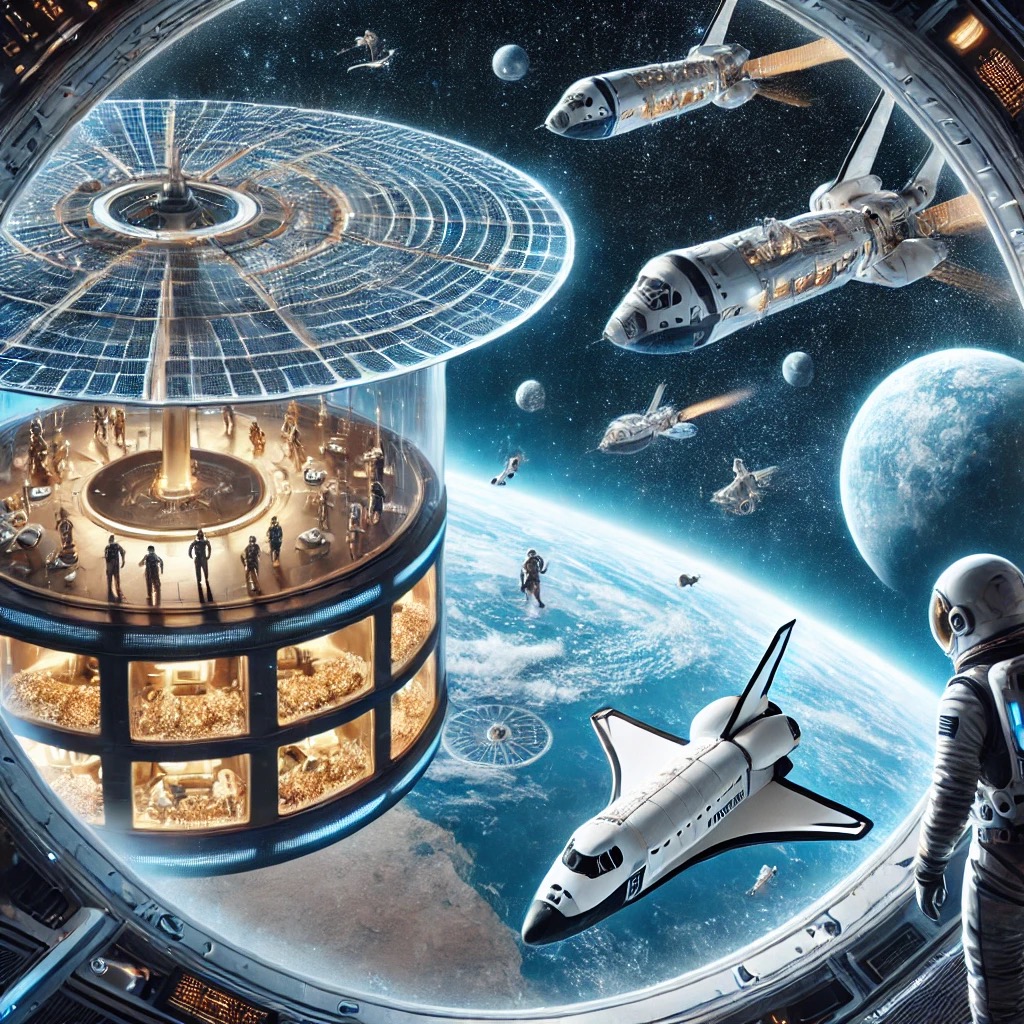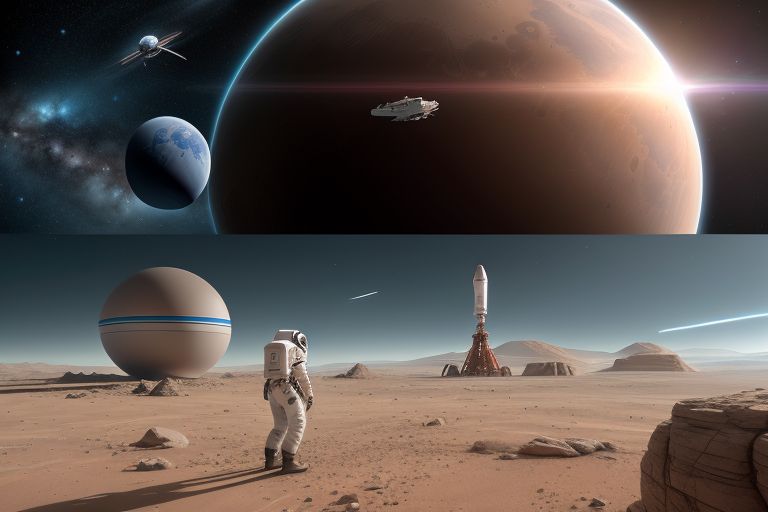Space tourism, once a distant dream confined to science fiction, is rapidly becoming a reality. With advancements in aerospace technology and the entry of private companies like SpaceX , Blue Origin , and Virgin Galactic , the prospect of civilians traveling beyond Earth’s atmosphere is no longer a fantasy but an emerging industry. This new frontier promises not only breathtaking experiences for adventurers but also transformative implications for science, economics, and humanity’s relationship with space.
Below is an exploration of the key aspects, benefits, challenges, and future prospects of space tourism, as well as its broader impact on society.

1. The Dawn of Space Tourism
a. Pioneering Companies
- Virgin Galactic : Focuses on suborbital flights, offering passengers a few minutes of weightlessness and stunning views of Earth.
- Blue Origin : Provides similar suborbital experiences with its New Shepard spacecraft, emphasizing accessibility and reusability.
- SpaceX : Aims for orbital and lunar missions, including plans for private trips around the Moon and potential Mars colonization.
- Other Players : Companies like Axiom Space and Space Adventures are working on orbital tourism and International Space Station (ISS) visits.
b. Milestones Achieved
- 2021 : Blue Origin’s first crewed flight carried Jeff Bezos and three others to the edge of space.
- 2021 : SpaceX’s Inspiration4 mission marked the first all-civilian orbital mission.
- 2023 : Plans for private ISS visits, lunar flybys, and even luxury space hotels are underway.
2. Types of Space Tourism
a. Suborbital Flights
- Lasting about 10–15 minutes, these flights reach the boundary of space (around 80–100 km above Earth) before returning.
- Passengers experience brief moments of weightlessness and panoramic views of Earth.
- Ideal for short, affordable trips targeting affluent tourists.
b. Orbital Flights
- These missions involve traveling at least 400 km above Earth to achieve sustained orbit, lasting several days or weeks.
- Examples include stays aboard the ISS or private orbital habitats.
- Requires significant training and investment, catering to ultra-high-net-worth individuals.
c. Lunar and Deep-Space Missions
- Ambitious projects aim to send tourists around the Moon or even land on its surface.
- SpaceX’s Starship is central to these efforts, with long-term goals of enabling human travel to Mars.

d. Space Hotels and Habitats
- Concepts like Orbital Assembly Corporation’s Voyager Station envision luxury accommodations in space, complete with amenities like zero-gravity sports and panoramic windows.
3. Benefits of Space Tourism
a. Economic Growth
- Job Creation : The space tourism industry will generate thousands of jobs in engineering, hospitality, and support services.
- Technological Innovation : Investments in space tech drive advancements that benefit other industries, such as medicine, transportation, and energy.
b. Scientific Advancement
- Research Opportunities : Civilian missions provide platforms for conducting experiments in microgravity, advancing fields like biology, materials science, and climate monitoring.
- Inspiration for STEM : Space tourism ignites public interest in science and exploration, inspiring the next generation of scientists and engineers.
c. Global Perspective
- Experiencing Earth from space fosters a deeper appreciation for our planet’s fragility and interconnectedness, promoting environmental stewardship and global unity.
d. Democratization of Space
- While initially exclusive, space tourism paves the way for broader access to space, potentially lowering costs over time and enabling more diverse participation.

4. Challenges and Risks
a. High Costs
- Current prices range from $250,000 (suborbital) to tens of millions (orbital), making space tourism inaccessible to most people.
- Significant investments are required to develop infrastructure and ensure safety.
b. Safety Concerns
- Space travel involves inherent risks, including launch failures, radiation exposure, and re-entry hazards.
- Ensuring passenger safety requires rigorous testing and regulatory oversight.
c. Environmental Impact
- Rocket launches emit greenhouse gases and contribute to atmospheric pollution, raising concerns about sustainability.
- Balancing innovation with ecological responsibility is critical.
d. Regulatory Frameworks
- Governments must establish clear guidelines for licensing, liability, and international cooperation to prevent conflicts and ensure accountability.
e. Ethical Questions
- Should resources be allocated to space tourism when pressing issues like poverty and climate change persist on Earth?
- How do we ensure equitable access to space without exacerbating social inequalities?
5. Real-World Examples
a. Virgin Galactic’s SpaceShipTwo
- Designed for suborbital flights, it offers passengers a unique view of Earth and a taste of weightlessness.
b. Blue Origin’s New Shepard
- Features a reusable rocket and capsule system, providing safe and efficient suborbital experiences.
c. SpaceX’s Crew Dragon
- Used for both government missions and private ventures, including Inspiration4 and planned lunar missions.
d. Axiom Space
- Partners with NASA to send private astronauts to the ISS, laying the groundwork for commercial space stations.
6. Emerging Trends in Space Tourism
a. Reusability
- Advances in reusable rockets reduce costs and increase the frequency of launches, making space travel more sustainable.
b. Space Habitats
- Companies are designing modular habitats for long-term stays, combining functionality with comfort.
c. Zero-Gravity Entertainment
- From concerts to sports events, zero-gravity environments offer unique entertainment opportunities.
d. Lunar Resorts
- Visionaries propose building resorts on the Moon, offering unparalleled luxury and adventure.
e. AI and Robotics
- Autonomous systems will play a crucial role in maintaining habitats, guiding tourists, and conducting research.
7. Broader Implications for Society
a. Cultural Shifts
- Space tourism challenges traditional notions of exploration, inspiring a sense of wonder and possibility.
- It reinforces humanity’s identity as a species capable of transcending planetary boundaries.
b. Geopolitical Dynamics
- As private companies lead the charge, nations may compete or collaborate to assert influence in space.
c. Technological Spin-Offs
- Innovations developed for space tourism often find applications in everyday life, improving healthcare, transportation, and communication.
d. Environmental Awareness
- Seeing Earth from space underscores the urgency of addressing climate change and preserving our planet.
8. The Future Vision of Space Tourism
The future of space tourism envisions a world where traveling to space becomes as routine as flying across continents. Key elements include:
a. Accessibility
- Lower costs and streamlined processes will make space travel available to a wider audience, not just the ultra-wealthy.
b. Interplanetary Travel
- Missions to the Moon, Mars, and beyond will expand humanity’s presence in the solar system, creating new opportunities for exploration and settlement.
c. Sustainable Practices
- Green technologies and renewable energy sources will minimize the environmental impact of space travel.
d. Global Collaboration
- Public-private partnerships and international cooperation will drive progress while ensuring ethical standards.
9. Conclusion
Space tourism represents a bold step toward a future where humanity ventures beyond Earth, unlocking new horizons and redefining what is possible. By blending adventure, innovation, and discovery, this burgeoning industry has the potential to inspire generations, advance scientific knowledge, and strengthen our connection to the cosmos.
However, realizing this vision requires addressing significant challenges related to cost, safety, regulation, and ethics. As we chart the course for space tourism, it is essential to balance ambition with responsibility, ensuring that this extraordinary endeavor benefits all of humanity.
The journey into space is not just about leaving Earth—it’s about expanding our understanding of who we are and where we belong in the universe. The era of space tourism has begun, and its possibilities are limitless.


